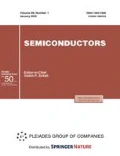Abstract
For modern microelectronics, at the present time, the technologies of consciousness smart structures play an important role, which can provide accuracy, stability and high quality of the structures. Submicron lithography methods are quite expensive and have natural size limitations, not allowing the production of structures with an extremely small lateral limitation. Therefore, an intensive search was conducted for alternative methods for creating submicron resolution structures. Especially attractive one is the possibility of self-organization effects utilization, where the nanostructure of a certain size is formed under the influence of internal forces. The dip pen nanolithography method based on a scanning probe microscope uses a directwrite technology and allows one to carry out a playback of small size structures with high accuracy. In the experiment, a substrate coated with Au (15 nm) using a DPN technique is applied to the polymer to form a desired pattern nano-sized channel. The experiment was conducted using a pointed probe SiN, coated MHA-Acetonitrile, on the Si(111)/Fe3Si/Au structure.
Similar content being viewed by others
References
A. E. Nel, L. Mädler, D. Velegol, T. Xia, and E. M. V. Hoek, Nat. Mater. 8, 543 (2009).
E. A. Vitol, V. Novosad, and E. A. Rozhkova, Nanomedicine, No. 7, 1611 (2012).
N. Okamoto et al., Nat. Mater. 13, 932 (2014).
J. H. Al-Taie et al., Appl. Phys. Lett. 102, 243102 (2013).
J. Haaheim, R. Eby, M. Nelson, J. Fragala, B. Rosner, H. Zhang, and G. Athas, Ultramicroscopy 103, 117 (2005).
Hua Zhang et al., Nanotechnology 14, 1113 (2003).
S. N. Varnakov, A. A. Lepeshev, S. G. Ovchinnikov, A. S. Parshin, M. M. Korshunov, and P. Nevoral, Instrum. Exp. Tech. 47, 839 (2004).
S. W. Chung, A. Mirkin, and H. Zhang, Nano Lett. 3, 43 (2010).
T. Harianto, K. Sadakuni, H. Akinaga, and T. Suemasu, Jpn. J. Appl. Phys. 47, 6310 (2008).
Author information
Authors and Affiliations
Corresponding author
Additional information
The article is published in the original.
Rights and permissions
About this article
Cite this article
Lukyanenko, A.V., Smolyarova, T.E. Alternative Technology for Creating Nanostructures Using Dip Pen Nanolithography. Semiconductors 52, 636–638 (2018). https://doi.org/10.1134/S1063782618050202
Received:
Published:
Issue Date:
DOI: https://doi.org/10.1134/S1063782618050202




